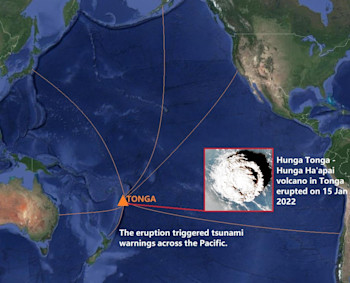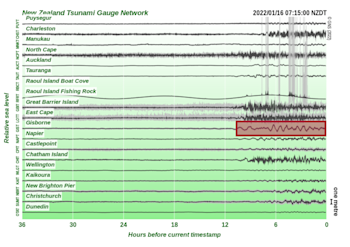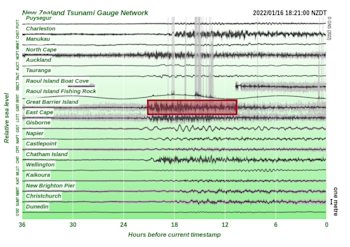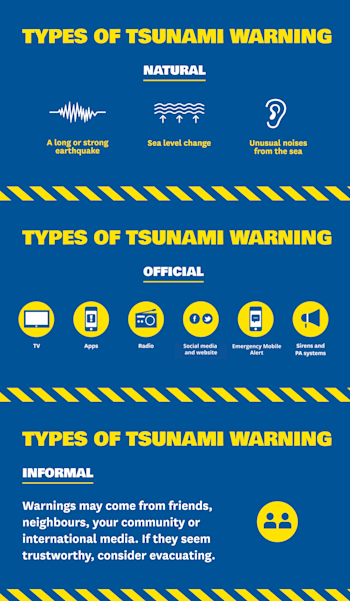
Hunga Tonga-Hunga Ha'apai eruption - information about the tsunami
At 5:20pm on Saturday 15 January, a large, impulsive eruption at Hunga Tonga-Hunga Ha’apai volcano in Tonga occurred causing tsunami activity on coastlines around the Pacific – observed as widely as the west coast of the USA, Peru, Japan and New Zealand.
A volcanic-source tsunami event is rare but not unprecedented. It’s one of those things scientists always talk about as a possibility, but they are far from common.
It is likely that the earlier 14 January eruption blew away part of the volcano above water, so water flowed into the extremely hot vent. This meant that the Saturday evening eruption initially occurred underwater and exploded through the ocean, causing a widespread tsunami. There are also a few other potential mechanisms that could have contributed to the tsunami. We won’t know for sure until scientists can investigate what happened at the volcano – and right now both ash clouds and limited communications with Tonga mean that we can’t be certain.
As soon as tsunami activity was reported following the eruption, the GNS Science team swung into action to assess the tsunami threat to New Zealand shores. The first sign of unusual activity came when the New Zealand DART buoy closest to Tonga triggered at 5:48pm. Over time, as data was recorded at more of our DART buoys and coastal tsunami gauges, we were able to build a picture of what threat there might be to New Zealand.
You can see the tsunami arrive at our coast on our coastal tsunami gauges. The tsunami activity can be identified from regular waves by the longer wave period of several minutes to over an hour. A good example of this is the data from Gisborne, where you can observe longer ups and downs of the tsunami arriving at that sensor.
Assessing this tsunami was different from assessing earthquake-source tsunamis that occur more frequently. Where our experts usually use tools like modelling and forecasting, for this volcano-source event they relied on real time observations from our DART buoy network. The DART network was invaluable in our ability to make assessments about when and where the tsunami might arrive as well as its amplitude.
Cyclone Cody was also a complicating factor. The storm caused heightened swells around the east coast of the North Island and made our data more difficult to decipher. Storm energy shows up in recordings with a much shorter period than tsunami waves and it can make picking out the signal of the tsunami very difficult. You can see this at the Great Barrier Island gauge from the weekend – the sea level is clearly going up and down, but it is very hard to detect the longer period waves of the tsunami from within all of the wave noise created by the storm.
Based on our assessments, the National Emergency Management Agency (NEMA) issued a National Advisory: Tsunami Activity for the east and north coast of the North Island and the Chatham Islands around 8:30pm on Saturday. This was extended to the West Coast of the South Island around 9:40am on Sunday based on further observations from the network. They warned people to expect strong and unusual currents and unpredictable surges at the shore.
Strong and unusual currents and unpredictable surges might not sound like much to worry about – but reports of damage and evacuations due to this weekend’s event are an important reminder that even a little tsunami can cause damage to property and be a life-safety risk.
Tsunami are different to normal wind generated waves - they’re more like a fast moving tide that just keeps coming, often surging faster than you can run (10-30km/h at the coast and travelling 400-800km/h in the open ocean).
Surges come in non-stop for around 5 minutes or more, and then recede just as fast for a similar period of time, acting more like a very rapid tide than a wave. This type of back-and-forth pattern (and sometimes weird eddies) continues for several hours. For someone fishing on the rocks, that relentless surge of water might be enough to knock them off their feet and not let them back up.
One of our experts John Ristau explains: "50-60cm is like trying to stand in a fast-flowing river that is about knee height, and really hard to stand in."
There are different types of tsunami warning, both official and natural. Knowing what to look out for and being prepared is the best way to keep you and your whānau safe.
And remember, if you feel shaking, Drop Cover and Hold to protect yourself from the earthquake first.
Then if it’s Long or Strong, Get Gone. Evacuate up to higher ground and away from the coast.
NEMA (National Emergency Management Agency) have a great website with information on what to do before, during and after a tsunami. There you can also find tsunami evacuation zone maps for around New Zealand, and what supplies you need in an emergency.
Attributable to Jonathan Hanson, GNS Science Earthquake and Tsunami Duty Officer. Media contact: 021 574 541 or media@gns.cri.nz








